How to Booster Draft
If you've ever been to a Prerelease event at your local game store, you will have played Sealed Deck. That's where you open up some booster packs (usually six of them) and build a Magic deck from the cards in those booster packs (plus basic lands). Then you play against other people who have done the same thing.
Sealed Deck is one form of Limited Magic—that is, a way to play the game where you open packs and build decks right there in one sitting. People love it because you never know which cards you'll open, and it compresses the whole Magic experience of getting cards, building decks, and playing games into one sitting.
Also, they love it because you can show up with a couple of dice and a piece of paper and have all you need to play in a real Magic event.
Sealed Deck is great, but the best experience you can have in Limited Magic, in my opinion, is Booster Draft. Here, you're going to learn what Booster Draft is and why it's great. I'll walk you through how a draft works, and you'll even get a solid baseline of advice to help you get started.
What Is Booster Draft?
In Draft, instead of just opening six booster packs and building a deck from the contents you find inside, we're going to go a full level deeper and draft the cards from the packs one at a time with a table of six or eight players.
As is often the case in English, there are multiple definitions of the word "draft"—one of which I used to create this article—but this is the one we'll be using today:
verb
select (a person or group of people) for a certain purpose.
Except instead of people, we'll be drafting Magic cards. You'll be selecting one card at a time from each pack to use in your deck. This gives you a level of agency over your final deck that you can't get in Sealed Deck, and it makes for a fascinating process on top of that.
For many lifelong Magic players, Booster Draft is the endgame. It's where you land after you've built all the Constructed decks you want to or when your life has changed to be less accommodating to playing a ton of Magic, like when you get a full-time job, have children, etc. For me, it was where I started. I loved that I could just sit down and play Booster Draft without needing a full Constructed deck already built.
It's also simply the best sit-down experience in all of gaming. I know those are big words, but I stand behind them 100%. I draft at least once most days, and I've never lost interest in it, even after having done so for years. For me, there are few activities that meet those criteria that don't involve pizza or Chinese food.
Assuming you are sufficiently convinced that Draft is awesome and fun (if not, reread the previous section), it's time to get down to business on how to actually do a draft.
How Do I Actually Do a Draft?
I tried to write this up a bunch of different ways in order to explain it, but I've decided that you are probably a lot like me: you just need to do it to truly understand it.
So we are going to walk through part of a draft together, and I'll explain what is happening as we go.
I'm also going to give some basic strategic advice after this section, to give you the best chance to succeed right off the bat. I won't be going deep on any specific strategies, as there is plenty of content out there on that and this article is aimed at people who have heard of Draft but haven't actually felt comfortable enough to try it out.
Let's get into it.
First things first, you'll start with a table of either six or eight players, most typically eight. You technically could do a draft with more or even fewer players, but the vast majority of your Draft experiences will be with six or eight players.
Ideally, you'll be seated at the table in a random order. Then you'll be handed your product, in this case three booster packs.
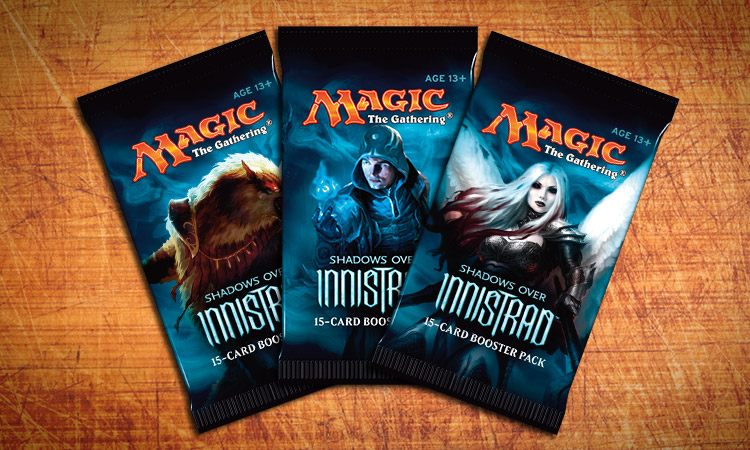
After everyone is settled in, you'll be instructed along with everyone else to open your first booster pack.
How exciting, right?
You open your booster pack and look at all the cards inside (probably starting with the rare if you are like most people).
A few things to note about your typical booster pack:
- There will be fourteen cards, plus a basic land and a token or ad card. You can ignore the basic land card and token for now.
- Of the fourteen cards, ten will be common, three will be uncommon, and one will be rare or mythic rare.
I'm using Shadows over Innistrad as the example for this article, because it's coming out at the time of writing and I'm excited about it.
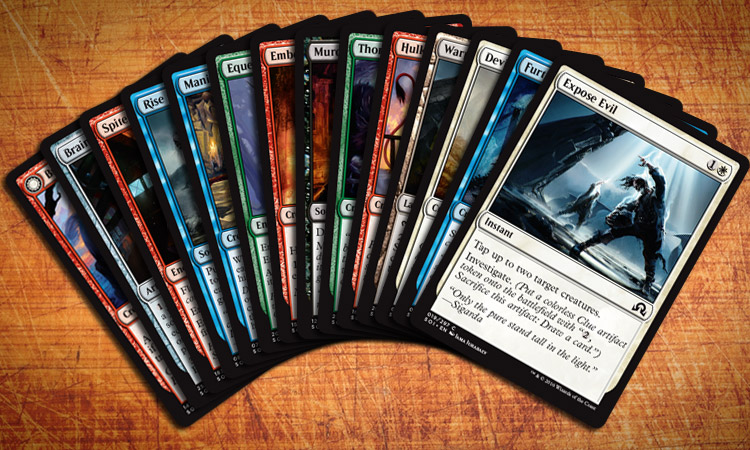
This, for many people, is the scary part. It can be pretty overwhelming to stare down fourteen cards, but fret not—it's not nearly as scary as it seems.
You are now going to pick one of these cards and put it in a separate pile.
This separate pile is your pool of cards, and it will grow over the course of the draft, eventually becoming the pool of cards from which you will build your 40-card deck. That's right, in Limited, we play with 40-card decks instead of the 60 or even 100 you'd see in some Constructed formats.
So which card do you take?
For such a simple question, the number of answers and the depth of those answers is something that will keep your brain occupied for years to come. For the purposes of this article, we won't be paying much attention to the strategy behind drafting Shadows over Innistrad.
Generally, you can take any card you think is sweet or powerful, or that does something you want to do.
Sometimes this will be a big and splashy rare card. Other times it will be a common card that removes creatures from your opponent's side of the board, or a good creature for you to attack and block with.
For your first few drafts, just take the card that looks the most interesting and powerful to you and don't kill yourself over the details (that part comes later in your drafting career).
I'm going to take the Murderous Compulsion, because it can kill a creature and I like killing creatures in Limited.
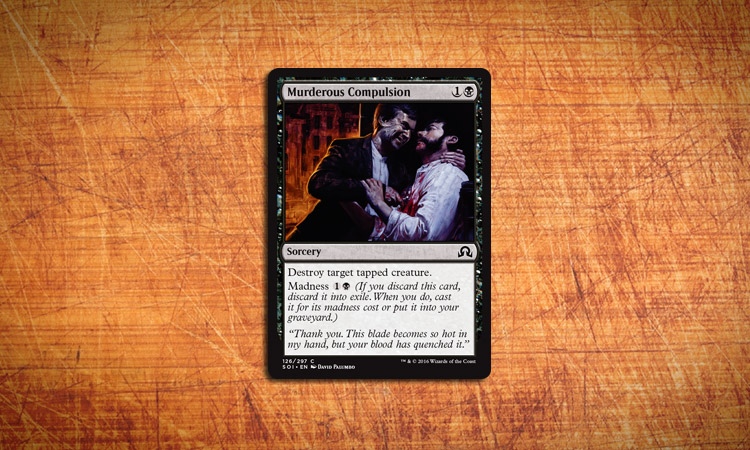
So now we have a Murderous Compulsion in our pool, and it's time to pass the rest of the pack to the player on our left.
She will have just taken a card from the pack she opened, and the person to our right will be passing his pack to us. Everyone will be taking one card from their pack and passing the rest of the cards to the person on their left side.
We'll now have a pack of thirteen cards in our hand (remember, the player to our right took his first pick from it), and we get to take one card from it for our deck.
Here's our pack:
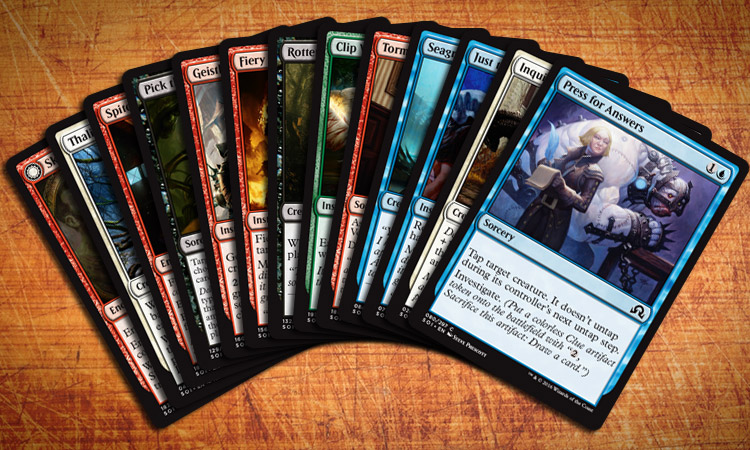
Here, we'll take the Thalia's Lieutenant, a cool-looking rare, and again pass the twelve remaining cards to the player on our left side.
Now our card pool looks like this:

Once again, here comes the third pack from the player on our right side. We'll take one card from it and pass the rest to the left like we did before. Here's our pack:
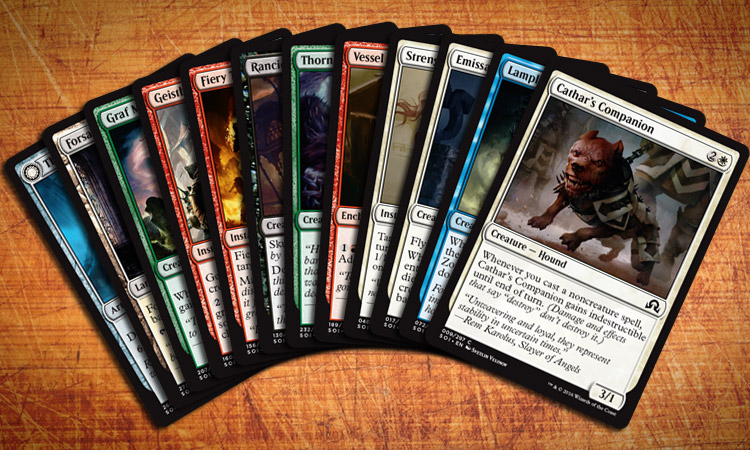
We'll grab a Rancid Rats for our card pool and pass the rest of the pack to the player on our left side again.
Our card pool looks like this now:
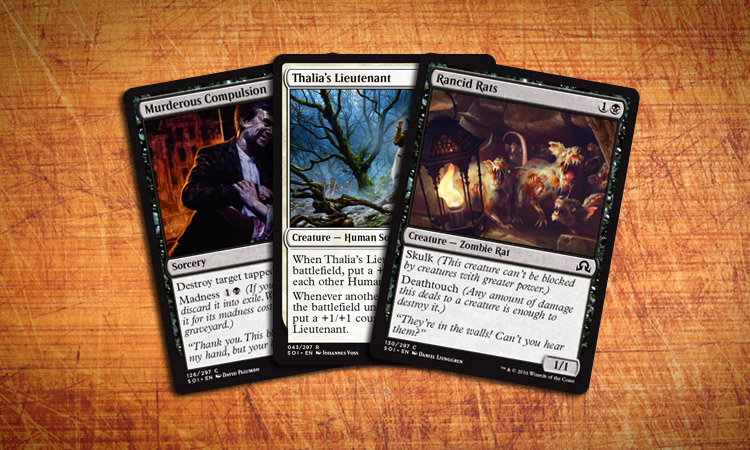
And thus it continues, until there aren't any more cards left in the pack.
Our card pool may look something like this after the first pack is done:
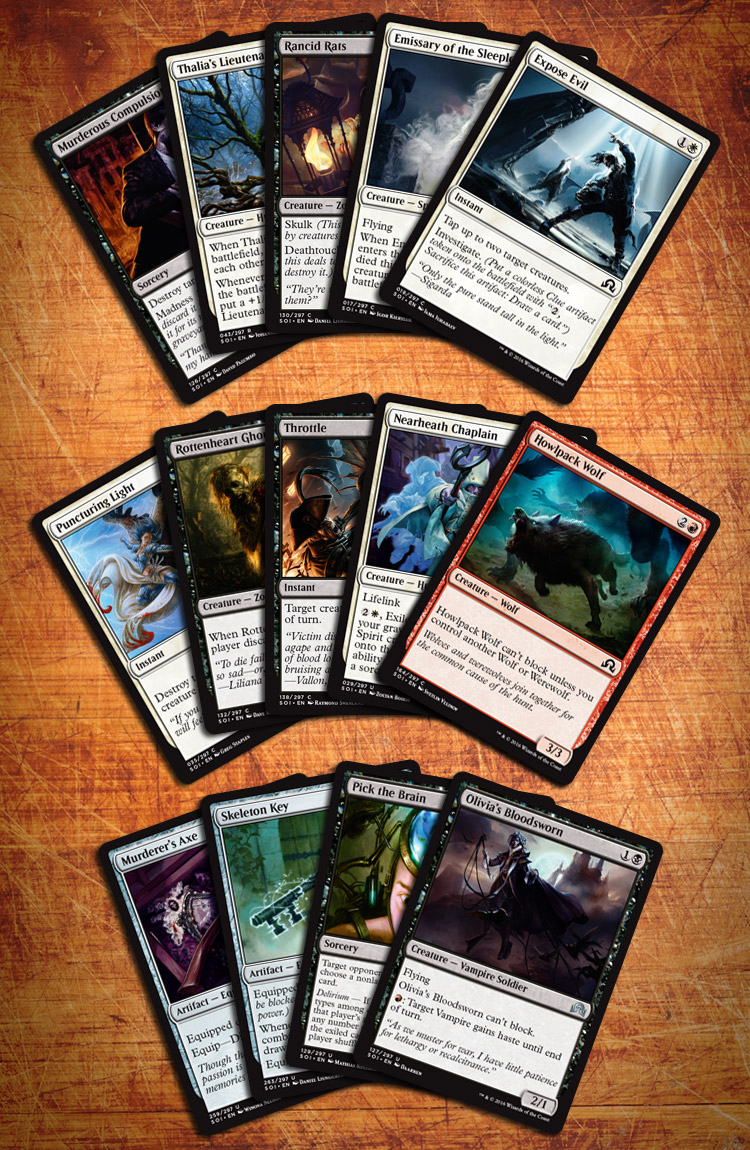
After all of the cards are taken from the first packs, you'll get a little time to look over your picks, and then we'll move on to pack two!
We'll be doing the exact same thing—opening the pack, selecting one card for our card pool, and passing the rest along. The only difference is that for pack two, we pass them to our right.
We'll continue doing this until everyone has picked all the cards from the packs, and then we'll do it one more time for the third pack. This time, we'll go back to passing to our left.
Once you get into the flow of it, it's quite natural.
After all three packs have been drafted, you'll have your pool of cards from which to build your 40-card deck. Pretty simple, actually!
What Advice Do You Have for Drafting and Building a Good Draft Deck?
Keeping it basic, here are some rules of thumb to follow for your Booster Draft decks:
Forty cards, and no more. You want to maximize your deck's potential, and that means playing only your very best cards. So stick to 40 cards, not 41 or more.
Seventeen lands is the industry standard, but occasionally you'll run eighteen or even sixteen. This is rare, and if you only ever ran seventeen lands in your deck you'd do just fine. When in doubt, lean toward running more lands rather than fewer. (As a side note, you get as many basic lands as you'd like for your deck, and you don't have to draft them. The shop you play at will have a "land station" with basic lands for you, so don't sweat that part.)
That leaves room for 23 spells of varying types. These will be your creatures, sorceries, instants, enchantments, artifacts, etc. Choosing which ones to put in your deck and which to leave in your sideboard (any cards that you don't play in your main deck automatically make up your sideboard in Limited) is one of the big skills in Limited.
I recommend playing fifteen to eighteen creatures in your deck. Creatures are the most important type of card in Limited. They are absolutely crucial to winning, and 99% or more of your wins will come from creature combat. Don't skimp on creatures!
I recommend playing two colors in most formats, and only two colors. This makes drafting and deck building more straightforward, as well as making your deck more consistent. After you get more experience, you can try "splashing" for a color, which is where you play just one or two cards of a third color in your deck. At the beginning, though, this isn't necessary and usually introduces more issues than it solves.
You may have heard about something called a "mana curve." And yes, this is an important topic in Draft. Basically, a mana curve refers to the spells you put in your deck and how much they cost to cast. It becomes obvious once you read a few cards that the more powerful cards cost more mana. So why not just put all of your most expensive and powerful cards in your deck? The reason is because you'll find yourself doing a whole lot of nothing in the early part of the game, and you'll often be dead long before you get to cast those big, powerful (and expensive) spells. The way to combat this is to have a good mana curve.
A good mana curve roughly consists of four to six two-mana creatures, six or seven three-mana creatures, three or four four-mana creatures, two or three five-mana creatures, and one or two six-or-more-mana creatures. Sometimes you'll play a few creatures that cost only one mana, but not often. Sometimes you'll even play creatures that cost seven mana or more, but they have to be pretty special to play, as you'll often not get to cast such expensive creatures.
One quick note: you can play as many copies of any given card as you draft, even if that number is more than four.
When it comes to your lands, you'll often have a split of nine and eight. So if you are playing blue and white, for example, you'll often have something like nine Islands and eight Plains, for a total of seventeen lands. Occasionally you'll want ten and seven.
That's it. If you stick to these guidelines, you'll have a solid fundamental strategy from which to build your knowledge base.
Now Go Forth and Draft!
Drafting is one of the most enjoyable and deep experiences you can have in gaming, which can make it seem more daunting than it actually is. Once you get out and try it, I'm confident that you'll love it and want to do it again as soon as possible. And once you start getting more comfortable with the whole process, a new world of fascinating strategy will open up for you—from the draft and which cards to pick, to the deck building and which cards to play, to the games and which creatures to attack with, it all comes together in the most beautiful and complete way.
I hope you've gained enough confidence to try it out. Stick to the guidelines I outlined above and you'll do just fine.
Now you just have to open some sweet rares.
